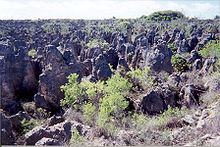- Monocalcium phosphate
-
Monocalcium phosphate  Calcium dihydrogenphosphateOther namesAcid calcium phosphate
Calcium dihydrogenphosphateOther namesAcid calcium phosphate
Calcium acid phosphate
Calcium biphosphate
Monobasic calcium phosphate
Monocalcium orthophosphate
Calcium diorthophosphate
Phosphoric acid, calcium salt (2:1)Identifiers CAS number 7758-23-8 
PubChem 24454 Properties Molecular formula CaH4P2O8 Molar mass 234.05 g/mol Appearance white powder Density 2.22 g/cm3 Melting point 109 °C
Boiling point 203 °C (decomposes)
Solubility in water 2 g/100 mL Hazards EU Index Not listed NFPA 704 Flash point Non-flammable Related compounds Other anions Calcium pyrophosphate Other cations Magnesium phosphate
Dicalcium phosphate
Tricalcium phosphate
Strontium phosphate phosphate (verify) (what is:
phosphate (verify) (what is:  /
/ ?)
?)
Except where noted otherwise, data are given for materials in their standard state (at 25 °C, 100 kPa)Infobox references Monocalcium phosphate is a chemical compound with the formula Ca(H2PO4)2. It is commonly found as the monohydrate, Ca(H2PO4)2·H2O.
Contents
Uses
Fertilizer
Phosphorus is an essential nutrient and therefore is a common component of agricultural fertilizers. Tricalcium phosphate Ca3(PO4)2, a major component of phosphate rock such as phosphorite,[1] apatite, and other phosphate minerals, is too insoluble to be an efficient fertilizer. Therefore it can be converted into the more soluble monocalcium phosphate, generally by the use of sulfuric acid H2SO4. The result is hydrated to turn the calcium sulfate into the dihydrate gypsum and sold as superphosphate of lime. Alternately phosphate rock may be treated with phosphoric acid to produce a purer form of monocalcium phosphate and is sold as triple phosphate.
Superphosphate
Superphosphate is a fertilizer produced by the action of concentrated sulfuric acid on powdered phosphate rock.[2]
- Ca3(PO4)2(s) + 2 H2SO4(aq) → 2 CaSO4(aq) + Ca(H2PO4)2(aq)
"In 1840, Justus Von Liebig wrote, 'The crops on the field diminish or increase in exact proportion to the diminution or increase of the mineral substances conveyed to it in manure.' Von Liebig was the first to discover that phosphate of lime in bone meal could be rendered more readily available to plants by treatment with sulfuric acid. Sir John Bennett Lawes about the same time discovered that phosphate rock underwent the same reaction and could be used as a source ingredient. In the 1840s, scientists found that coprolites could be dissolved in sulfuric acid to produce what became known as superphosphate. Bennett Lawes was the first to manufacture superphosphate at his factory in Deptford, England in 1842."[3]
An expanded market for superphosphate emerged in the second half of the 20th century by the development of aerial topdressing in New Zealand which allowed superphosphate to be spread economically over large areas.
Superphosphate can be formed naturally in large quantities by the buildup of guano, or bird feces, resulting in deposits around sea bird colonies which can be mined. The most famous mining site is the island of Nauru in the South Pacific from which much of the "soil" was mined, producing temporary wealth for the inhabitants.
Triple superphosphate
Triple superphosphate is a fertilizer produced by the action of concentrated phosphoric acid on ground phosphate rock.[2]
Ca3(PO4)2(s) + 4 H3PO4(aq) → 3 Ca 2+(aq) + 6 H2PO41-(aq) → 3 Ca(H2PO4)2(aq)
The active ingredient of the product, monocalcium phosphate, is identical to that of superphosphate, but without the presence of calcium sulfate that is formed if sulfuric acid is used instead of phosphoric acid. The phosphorus content of triple superphosphate (17 - 23% P; 44 to 52% P2O5) is therefore greater than that of superphosphate (7 - 9.5% P; 16 to 22% P2O5). Triple superphosphate was the most common phosphate (P) fertilizer in the USA until the 1960s, when ammonium phosphates became more popular. It is produced in granular and nongranular form and is used both in fertilizer blends (with potassium and nitrogen fertilizers) and by itself.
Leavening agent
Calcium dihydrogen phosphate is also used in the food industry as a leavening agent to cause baked goods to rise. Because it is acidic, when combined with an alkali ingredient, commonly sodium bicarbonate (baking soda) or potassium bicarbonate, it reacts to produce carbon dioxide and a salt. Outward pressure of the carbon dioxide gas causes the rising effect. When combined in a ready-made baking powder, the acid and alkali ingredients are included in the right proportions such that they will exactly neutralize each other and not significantly affect the overall pH of the product.
See also
References
- ^ "Phosphate Rock". Mineral Information Institute. http://www.mii.org/Minerals/photophos.html#sources. Retrieved 2009-07-08.
- ^ a b McMurry, John; Fay, Robert C. (2004). Chemistry (4 ed.). Prentice Hall. pp. 841–2.
- ^ "About Yara: History". Yara International ASA. http://fert.yara.co.uk/en/about_us/history/index.html. Retrieved 2009-07-08.
- Yara corporate History Accessed May 2007
- Havlin, J.L., J.D. Beaton, S.L. Tisdale, and W.L. Nelson. 2005. Soil Fertility and Fertilizers. 7th edn. Pearson Prentice Hall, N.J.
Calcium compounds CaB6 · CaBr2 · CaC2 · CaCN2 · CaCO3 · CaC2O4 · CaCl · CaCl2 · Ca(ClO)2 · Ca(ClO3)2 · CaCrO4 · CaF2 · CaH2 · Ca(HCO3)2 · CaH2S2O6 · CaI2 · Ca(IO3)2 · Ca(MnO4)2 · Ca(NO3)2 · CaO · CaO2 · Ca(OH)2 · CaS · CaSO3 · CaSO4 · CaSi2 · CaTiO3 · Ca2P2O7 · Ca2SiO4 · Ca3(AsO4)2 · Ca3(BO3)2 · Ca3(C6H5O7)2 · Ca3N2 · Ca3P2 · Ca3(PO4)2 · Ca(H2PO4)2 · CaHPO4 · C36H70CaO4
Categories:- Food additives
- Phosphates
- Calcium compounds
- Acid salts
- Fertilizers
Wikimedia Foundation. 2010.



